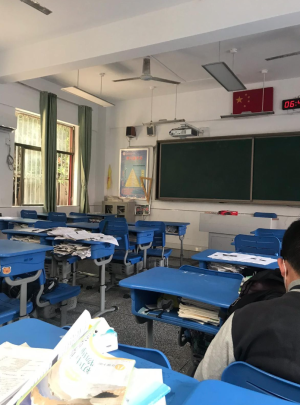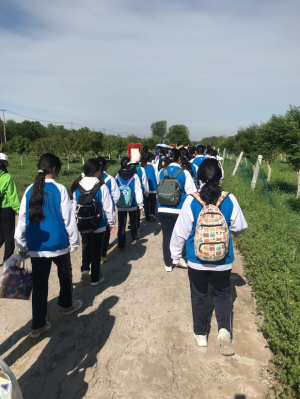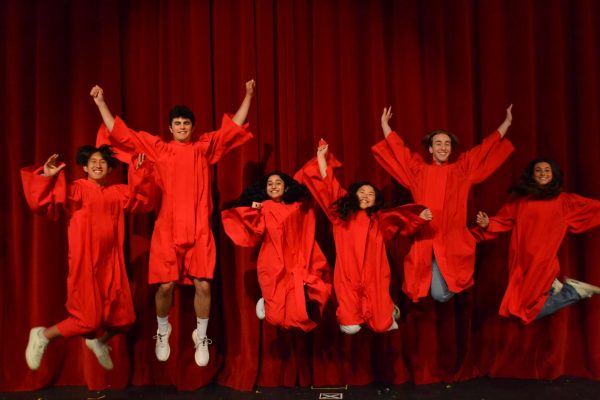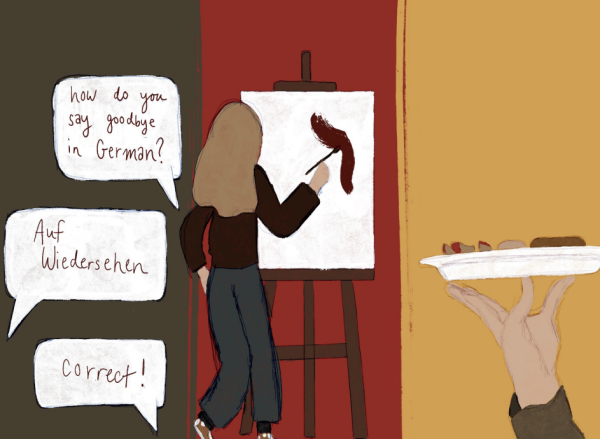East student Iris Yuan (‘25) spends time abroad studying in China
Students from China signing Yuan’s uniform.
In April, East student Iris Yuan (‘25) left the halls of East behind, traveling halfway across the world to China. There, she spent two months living and studying in Xuzhou, a city in the country’s Jiangsu province. Yuan, who is fifteen, attended a local middle school – in China, middle school spans from 7th grade to 9th grade – where she was in chu san (the Chinese term for the final year of middle school). From the long fourteen-hour school days to the primarily academics-focused culture, attending school in China presented a new and unique environment.
In China, Yuan’s school day started at 6:30 am and ended at 8:30 pm. With no bussing system, most students biked, walked, or, in Yuan’s case, took the subway to arrive at school each morning. Class started with a self-study period, similar to a study hall at East. Students would complete independent work for about an hour, and afterward, the ban zhu ren (homeroom teacher) for Yuan’s class, who happened to be an English teacher, would help them review English.
At around 7:50 on Mondays, Yuan and the other students went outside and watched the raising of the flag. Tuesday through Saturday, they instead participated in morning exercises, which took place on the track.
“They played [this] specific music, which apparently is the same for every school,” said Yuan. “And then you have [to] run to the music and there’s a teacher standing on the platform shouting into a megaphone. [They’re] shouting like ‘this class isn’t running’, ‘their formation isn’t straight’, and stuff like that.”
Following morning activities, students took four 45-minute classes, each with 10-minute breaks in between. Subjects varied between history, math, biology, art, music, and more. Unlike at East and most schools in the U.S., Chinese students remain in their homeroom classroom for all their classes, with the teachers moving around to different classrooms. Additionally, this means students remain with the same classmates (Yuan’s class had approximately forty students) for the entire day.
Next, Yuan and her classmates had a 30-minute lunch – instead of going to a cafeteria, students had boxed lunches delivered to the door and ate in their classrooms. After lunch was another 45-minute self-study session, and finally, a designated 45-minute nap time.
Once students had rested, they took four more classes, participated in an afternoon run (much like the morning exercises), and then had two more “extra” classes, which Yuan explains typically consisted of extra studying for the morning classes. At around 6:00 pm, students ate dinner at school, before taking another two classes until 8:30 pm, after which school ended. Though the school day is long, said Yuan, students usually don’t have much homework.

With such a rigorous schedule and focus on studying, Yuan says she did fall for some stereotypes about the intense school system in China.
“[I thought] everyone would be super strict and no one would ever think to do this or that and be like bad students,” said Yuan. However, she found that her classmates goofed off and could be immature sometimes, just like any other teenager.
Similarly, many of her classmates had their own expectations for American students. Yuan says most of the other students had never left the country before, and many were curious to learn more about Yuan’s life back in the United States.
“Their biggest stereotype was that school in America is really, really easy,” said Yuan. “[They think] it’s easy to get into college and stuff like that.”
Unlike the United States, China’s college admissions process predominantly relies on just one exam – the gaokao – that is taken at the end of students’ senior year. The gaokao is notoriously difficult, and Chinese students study tirelessly for years with the hope of scoring well. However, this exam culture begins years before students sit for the gaokao. At the end of middle school (which in China, spans up to the equivalent of freshman year), all Chinese students take a multi-day high school placement exam known as zhongkao (directly translating to “middle exam”). The zhongkao determines the trajectory of students’ future education: it determines the quality of the school they can attend and ultimately, whether or not they will even be able to attend a high school.
Yuan explained while 50% of students do not get into a high school, they will instead go on to a special skills school that prepares them for jobs such mechanic or cook, and then are typically able to find a job after they graduate, in three to four years.

Despite the long school days and academic stress, Yuan recalls many happy experiences from her time abroad, from going to the mall with her friends to her last day of school, when her classmates all signed her school uniform (most schools in China require their students to wear tracksuit-like uniforms).
“The kids were all really nice and easy to make friends with,” said Yuan. “I never had actual friends in China, besides my relatives and my cousins. This was my first time actually going to China and being able to meet people my age and make friends.”
She says her biggest takeaway from the experience is that despite the thousands of miles between us, American students and Chinese students aren’t so different after all.
“[The difference] is honestly not as dramatic as we perceive it to be,” said Yuan. “Maybe there’s differences like [Chinese students] are more stressed on this one big test and maybe we’re more stressed on like our overall grades, but we’ve been through a lot of similar experiences.”

Sophia Liu is a senior and one of this year's Eastside Editor-in-Chiefs. When she's not chasing a story, Sophia can be found on the East tennis courts,...











